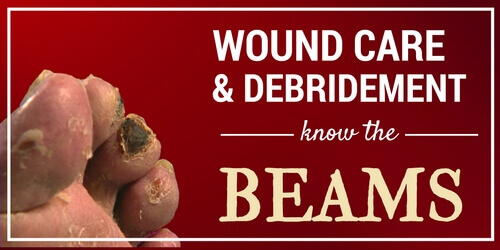What is Debridement?
Wound debridement is the removal of necrotic, dead tissue from the wound bed. It also plays a vital role in the tissue management concept of wound bed preparation. Wound bed preparation is the comprehensive approach we use to get our chronic wounds to heal. There are two main categories of debridement: selective and non- selective. Selective methods are when only necrotic, non-viable tissue is removed from the wound bed. Non-selective methods remove both necrotic tissue and viable living tissue.
The 5 Major Debridement Methods
These five major debridement methods for wound clinicians are easy to remember (BEAMS), and key to the wound healing process. Debridement methods can be categorized under two main types.
Selective Methods
Methods where only necrotic, non-viable tissue is removed from the wound bed.
- Biological debridement
- Enzymatic debridement
- Autolytic debridement
Non-Selective Methods
Methods that remove both necrotic tissue and viable living tissue.
- Mechanical debridement
- Sharp debridement
Biological Debridement
Biological debridement is also known as maggot debridement and involves using sterile medical maggots to remove necrotic tissue. These sterile maggots debride necrotic tissue by liquefying and digesting it, they also kill and ingest bacteria while stimulating wound healing.
Enzymatic Debridement
Enzymatic debridement is the use of collagenase ointment (Santyl) once daily to the wound bed. The ointment works from the bottom up to loosen the collagen that holds the necrotic material to the wound bed. It is a faster method than autolytic debridement, but slower than sharp debridement.
Autolytic Debridement
Autolytic debridement is the slowest type. It uses the body’s own enzymes to assist in breaking down the necrotic tissue. This is achieved by using products that maintain a moist wound environment. This type of debridement is not appropriate for large amounts of necrotic tissue or infected wounds.
Mechanical Debridement
Mechanical debridement is a method that uses an external force to separate the necrotic tissue from the wound bed. This may be painful and removes non-viable as well as viable tissue. Methods include wet to dry dressings, scrubbing, whirlpool, and irrigation. Contraindications for mechanical debridement would be epithelializing and granulating wounds.
Sharp Debridement
The fastest method of debridement is the sharp method. There are 2 types, sharp surgical (done by a surgeon, physician, or podiatrist) or sharp conservative (done at bedside by a trained clinician). It involves the use of scalpels, scissors, curettes, or forceps. Sharp surgical is a major procedure that sacrifices some viable tissue, whereas sharp conservative is a minor procedure done at the bedside that removes non-viable tissue.
Which Method is Best?
The debridement method you choose for treatment will be based on a variety of factors, all of which need to be considered. These include:
- Wound characteristics
- Amount of necrotic tissue in wound
- Efficiency and selectivity of the debridement method itself
- Pain management for the patient
- Procedure cost
- Exudate levels of the wound
- Presence or risk of infection
- Patient care setting
- Patient’s overall medical condition
It is also important to remember that not every patient with necrotic tissue will be a candidate for debridement. Be sure that you understand indications and contraindications for each debridement method when you are selecting the appropriate one for your patient.
Take our engaging, evidence-based Wound Care Certification Courses for nurses, registered dietitians, physical therapists, and more professionals. Choose the format that suits you and get access to tools to help you ace your exam.
Want to learn more about Wound Debridement and Care?
Get Started →What do you think?

